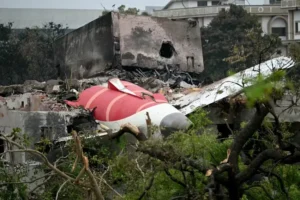On June 12, 2025, the aviation world was shaken by a devastating tragedy in Ahmedabad, India, when Air India Flight AI171, a Boeing 787-8 Dreamliner bound for London’s Gatwick Airport, crashed moments after takeoff. The catastrophic incident claimed the lives of 241 of the 242 passengers and crew onboard, with additional casualties on the ground, marking it as one of the worst aviation disasters in a decade. The recovery of the plane’s two black boxes—the flight data recorder (FDR) and cockpit voice recorder (CVR)—has sparked hope that investigators can uncover the reasons behind this heartbreaking event. As the world awaits answers, the black boxes are poised to reveal critical clues about what went wrong in the fleeting 33 seconds between takeoff and the fiery crash.
The Tragic Moments of Flight AI171
The ill-fated flight took off from Sardar Vallabhbhai Patel International Airport in Ahmedabad at approximately 1:39 p.m. local time. According to preliminary reports, the aircraft reached an altitude of just 625 feet—barely 400 feet above the ground when accounting for the airport’s elevation—before it began to lose height rapidly. Within moments, the plane issued a desperate mayday call to air traffic control, with the pilot reporting a lack of thrust. Seconds later, the Boeing 787-8 Dreamliner plummeted into a medical college hostel, erupting into a massive fireball that left a trail of destruction and grief.
The crash site was a scene of unimaginable horror. The plane’s impact with the hostel, a residential building housing medical students and their families, resulted in additional casualties on the ground, with estimates suggesting at least 29 people perished in the blaze. Only one passenger, 40-year-old Vishwashkumar Ramesh, miraculously survived and is currently recovering in a local hospital. The scale of the disaster has drawn global attention, with families of the victims, aviation experts, and the public seeking answers to the question: What caused this unprecedented tragedy?
The Role of the Black Boxes
In the aftermath of the crash, investigators from India’s Aircraft Accident Investigation Bureau (AAIB) worked tirelessly to recover critical evidence from the wreckage. On June 13, the digital flight data recorder was retrieved from the rooftop of the medical college hostel, a significant breakthrough in the investigation. The cockpit voice recorder, the second of the two black boxes, was also located, though its condition remains undisclosed. These devices, often referred to as “black boxes” despite their bright orange color, are designed to withstand extreme conditions and hold the key to understanding the sequence of events that led to the crash.

The flight data recorder captures hundreds of parameters, including altitude, speed, engine performance, and control inputs, providing a detailed timeline of the aircraft’s behavior. The cockpit voice recorder, meanwhile, captures conversations between the pilots, communications with air traffic control, and any ambient sounds, such as alarms or mechanical noises, that could indicate problems. Together, these devices offer a comprehensive picture of the final moments of Flight AI171, from the takeoff roll to the catastrophic impact.
Early Theories and Speculation
While the black boxes are still being analyzed, early speculation has focused on several potential causes. The pilot’s distress call, which mentioned a lack of thrust, suggests possible engine issues. The Boeing 787-8 Dreamliner is powered by two General Electric GEnx engines, and investigators are examining whether one or both engines failed during the critical climb phase. Twin-engine aircraft like the 787 are designed to operate on a single engine in emergencies, so a simultaneous failure of both engines would be an extraordinarily rare event, potentially pointing to a deeper systemic issue.
Another area of focus is the aircraft’s flaps and landing gear. Video footage captured by a local teenager, Aryan Asari, shows the plane struggling to gain altitude, with its landing gear still extended and flaps possibly retracted. Flaps are critical for generating lift during takeoff, and their premature retraction could have caused the plane to stall. Similarly, the failure to retract the landing gear, which increases drag, may have contributed to the aircraft’s inability to climb. These observations have fueled theories about possible mechanical failures or human error, with some experts suggesting that the co-pilot may have inadvertently misconfigured the aircraft’s systems.
The investigation is also considering environmental factors, such as high temperatures or a possible bird strike, though no evidence of explosives or sabotage has been found. The plane’s long runway roll—nearly exhausting the 3.5-kilometer runway—has raised questions about whether it achieved adequate speed for takeoff, further complicating the puzzle.
The Investigation Process
Decoding the black boxes is a meticulous process that requires advanced technology and expertise. India’s civil aviation ministry recently inaugurated a state-of-the-art laboratory in Delhi, equipped to analyze data from flight recorders and reconstruct flight paths using computer animations. This facility, built to international standards, represents a significant step forward for India’s aviation safety infrastructure. However, if the black boxes are damaged or require specialized analysis, they may be sent to a more advanced facility, likely in the United States, given Boeing’s involvement.

The AAIB is leading the investigation, with assistance from international experts, including a team from the UK’s Air Accidents Investigation Branch. The U.S. National Transportation Safety Board (NTSB) may also play a role, particularly if the black boxes are sent abroad for analysis. The process of decoding the data could take weeks, but initial findings may emerge sooner if the recorders are in good condition. Aviation safety consultant Jeff Guzzetti, a former NTSB investigator, has suggested that key questions—such as whether the flaps were set correctly, the engines lost power, or alarms were triggered—could be answered within days.
Implications for Aviation Safety
The crash of Flight AI171 is the first fatal incident involving a Boeing 787 Dreamliner since the aircraft entered commercial service in 2011. The 787, known for its advanced technology and fuel efficiency, has an exemplary safety record, with approximately 1,200 units in operation worldwide. The tragedy has raised concerns about the aircraft’s design, maintenance, and operational procedures, prompting India’s Directorate General of Civil Aviation (DGCA) to order immediate safety inspections of all Boeing 787s operated by local carriers, including Air India’s fleet of 33 aircraft and IndiGo’s single 787.
Boeing, already under scrutiny for safety issues with other aircraft models, has pledged full support to Air India and the investigation. The company’s reputation is on the line, as public confidence in air travel has been shaken by this disaster. The crash has also reignited discussions about aviation safety standards in India, with calls for enhanced training, maintenance protocols, and regulatory oversight.
The Human Toll
Beyond the technical aspects of the investigation, the human cost of the crash is staggering. The 241 passengers and crew included 169 Indian nationals, 53 British citizens, seven Portuguese, and one Canadian, reflecting the global impact of the tragedy. On the ground, the loss of life among medical students and their families has devastated the Ahmedabad community. Families of the victims are enduring an agonizing wait for DNA test results to identify remains, with only nine bodies identified so far.
Prime Minister Narendra Modi visited the crash site and met with the lone survivor, Vishwashkumar Ramesh, offering condolences and prayers for those affected. The government has promised swift action to support grieving families and ensure a thorough investigation. Stories of loss, such as that of 14-year-old Kalpeshbhai Patni, who perished in the hostel, have underscored the profound grief felt across the nation.
Looking Ahead
As the black boxes are decoded, the world awaits answers that could prevent future tragedies. The data they contain will likely clarify whether the crash resulted from mechanical failure, human error, or a combination of factors. For now, the aviation community is focused on learning from this disaster to enhance safety measures and restore public trust in air travel.
The crash of Air India Flight AI171 is a sobering reminder of the fragility of human life and the complexities of modern aviation. While the black boxes hold the promise of truth, they also carry the weight of a nation’s sorrow and the hopes of families seeking closure. As investigators piece together the final moments of the flight, the lessons learned will shape the future of aviation safety, ensuring that the lives lost are not forgotten.


